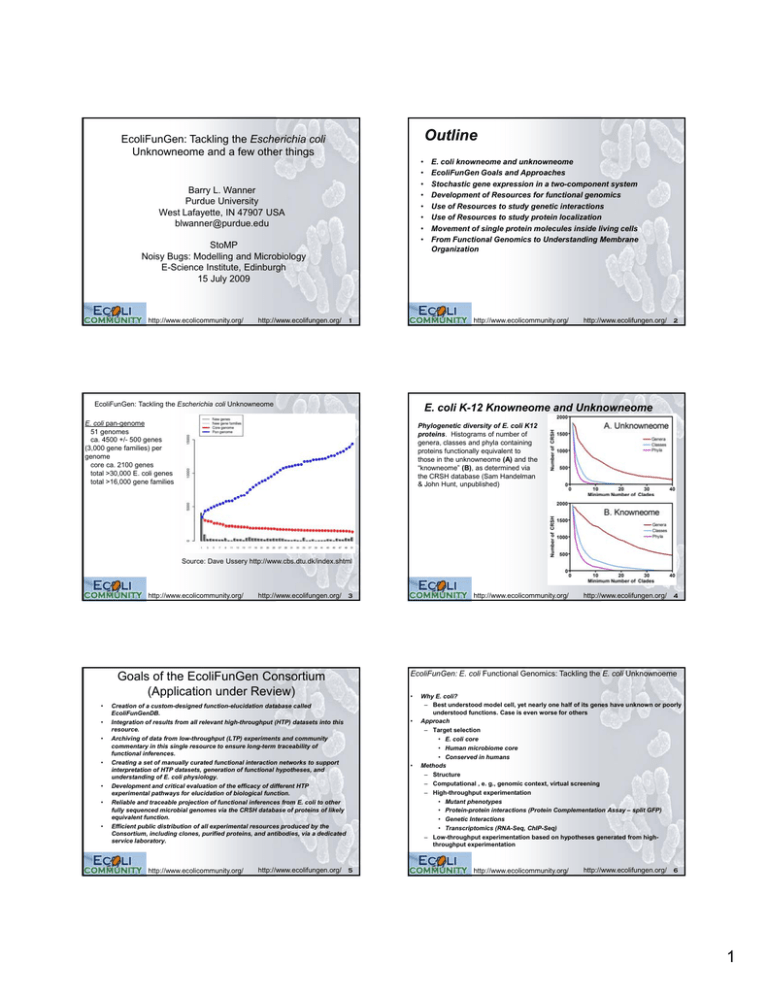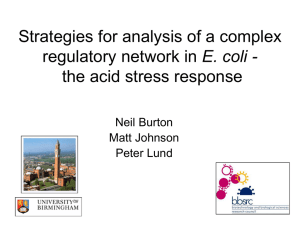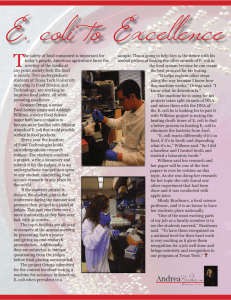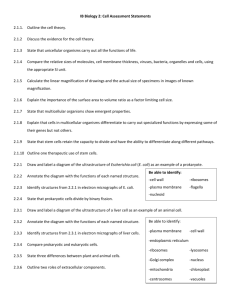Outline Escherichia coli Unknowneome and a few other things
advertisement

Outline EcoliFunGen: Tackling the Escherichia coli Unknowneome and a few other things • • • • • • • • Barry L. Wanner Purdue University West Lafayette, IN 47907 USA bl blwanner@purdue.edu @ d d StoMP Noisy Bugs: Modelling and Microbiology E-Science Institute, Edinburgh 15 July 2009 http://www.ecolicommunity.org/ http://www.ecolifungen.org/ 1 E. coli knowneome and unknowneome EcoliFunGen Goals and Approaches Stochastic gene expression in a two-component system Development of Resources for functional genomics Use of Resources to study genetic interactions yp protein localization Use of Resources to study Movement of single protein molecules inside living cells From Functional Genomics to Understanding Membrane Organization http://www.ecolicommunity.org/ EcoliFunGen: Tackling the Escherichia coli Unknowneome http://www.ecolifungen.org/ 2 E. coli K-12 Knowneome and Unknowneome E. coli pan-genome 51 genomes ca. 4500 +/- 500 genes (3,000 gene families) per genome core ca. 2100 genes total >30,000 E. coli genes total >16,000 gene families Phylogenetic diversity of E. coli K12 proteins. Histograms of number of genera, classes and phyla containing proteins functionally equivalent to those in the unknowneome (A) and the “knowneome” (B), as determined via the CRSH database (Sam Handelman & John Hunt, unpublished) Source: Dave Ussery http://www.cbs.dtu.dk/index.shtml http://www.ecolicommunity.org/ http://www.ecolifungen.org/ 3 Goals of the EcoliFunGen Consortium (Application under Review) • • • • • • • Creation of a custom-designed function-elucidation database called EcoliFunGenDB. Integration of results from all relevant high-throughput (HTP) datasets into this resource. Archiving of data from low-throughput (LTP) experiments and community commentary in this single resource to ensure long-term traceability of functional inferences. Creating a set of manually curated functional interaction networks to support interpretation of HTP datasets, generation of functional hypotheses, and understanding of E. coli physiology. Development and critical evaluation of the efficacy of different HTP experimental pathways for elucidation of biological function. Reliable and traceable projection of functional inferences from E. coli to other fully sequenced microbial genomes via the CRSH database of proteins of likely equivalent function. Efficient public distribution of all experimental resources produced by the Consortium, including clones, purified proteins, and antibodies, via a dedicated service laboratory. http://www.ecolicommunity.org/ http://www.ecolifungen.org/ 5 http://www.ecolicommunity.org/ http://www.ecolifungen.org/ 4 EcoliFunGen: E. coli Functional Genomics: Tackling the E. coli Unknownoeme • • • Why E. coli? – Best understood model cell, yet nearly one half of its genes have unknown or poorly understood functions. Case is even worse for others Approach – Target selection • E. coli core • Human microbiome core • Conserved in humans Methods – Structure – Computational , e. g., genomic context, virtual screening – High-throughput experimentation • Mutant phenotypes • Protein-protein interactions (Protein Complementation Assay – split GFP) • Genetic Interactions • Transcriptomics (RNA-Seq, ChIP-Seq) – Low-throughput experimentation based on hypotheses generated from highthroughput experimentation http://www.ecolicommunity.org/ http://www.ecolifungen.org/ 6 1 Signal transduction and stochastic expression in a seven-component, two-component system Results from a Systematic Search for Cross Activation of PhoB by non-partner Histidine Kinases - A Multi-Component Regulatory Network PhoQ/ PhoP EnvZ/OmpR BasS/ BasR RstB/ RstA • Figure removed because model is in manuscript under review ArcB/ ArcA KdpD/ KdpE CusS/ CusR PhoR/PhoB YedV/ YedW QseC/ QseB BaeS/ BaeR TorS/ TorR CpxA/ CpxR BarA/UvrY CreC/ CreB Summary: HK/RR; Tested fourteen; four showed strong activation (grey ovals), two showed weak cross activation (open ovals), and eight showed no cross activation (no arrows). J. L. Masella & B. L. Wanner, unpublished data http://www.ecolicommunity.org/ http://www.ecolifungen.org/ 7 •Stochastic variation in gene expression Single-cell profiling of PhoB activation by noncognate HKs http://www.ecolicommunity.org/ http://www.ecolifungen.org/ 8 Single-cell profiling of PhoB activation by noncognate HKs L. Zhou, G. Gregori, J. M. Blackman, J. P. Robinson, and B. L. Wanner. Stochastic activation of the response regulator PhoB by noncognate histidine kinases. In: IMBio, Informations management in der Biotechnologie e. V., edited by R. Hofestädt, Magdeburg: 2005, p. 11-24. http://www.ecolicommunity.org/ http://www.ecolifungen.org/ 9 Stochastic activation of Pho Regulon in normal cells http://www.ecolicommunity.org/ http://www.ecolifungen.org/ 10 Modeling: Stochastic kinetic model of two component system signalling reveals all-ornone, graded and mixed mode stochastic switching responses Andrzej M. Kierzek, Lu Zhou, Barry L. Wanner (manuscript under review) Summary from Modeling 1) Summary statements removed for they are in abstract of manuscript under review A Chromosome att80 ::phoAp-gfp in wt background B pLZ91 (CAS3)::phoAp-gfp in attf80 background Single cell profiling of PhoB activation by PhoR during Pi starvation Unpublished data cited in: M. G. Lamarche, B. L. Wanner, S. Crepin, and J. Harel. The phosphate regulon and bacterial virulence: a regulatory network connecting phosphate homeostasis and pathogenesis. FEMS Microbiol.Rev. 32 (3):461-473, 2008. http://www.ecolicommunity.org/ http://www.ecolifungen.org/ 11 http://www.ecolicommunity.org/ http://www.ecolifungen.org/ 12 2 Phase contrast and fluorescence images of phoAp-gfp in rhaBp-arcB (sample with cell OD410 of 0.7) Now under way Collaborators Ken Ritchie, Physics, Purdue Alex Groisman, Physics, UCSD B A •Single cell gene expression Field 1 Growing E. coli on a “chip” Chamber size: 5 m by 70 m Connections: 0.5 m diameter C D Groisman et al., Nature Meth., 685-689 (2005) Field 2 Phase contrast (A and C) and fluorescence ( B and D) images of two fields that were acquired at 100X magnification with a fluorescent microscope. L. Zhou, G. Gregori, J. P. Robinson, and B. L. Wanner. (unpublished data) http://www.ecolicommunity.org/ http://www.ecolifungen.org/ 13 E. coli Functional Genomics: Development of Resources In collaboration with Professor Mori and his Groups http://www.ecolicommunity.org/ http://www.ecolifungen.org/ 14 E. coli Functional Genomics: Development and Use of Resources Yamagata Nara Hirotada Mori, NAIST, Ikoma, ASKA Region, & Institute Advanced Biosciences, Keio University, Tsuruoka, Yamagata Prefecture, Japan Yamagata Nara http://www.ecolicommunity.org/ http://www.ecolifungen.org/ 15 http://www.ecolicommunity.org/ http://www.ecolifungen.org/ 16 E. coli Functional Genomics: Development and Use of Resources (C) ASKA single gene knockout library (manuscript in preparation) Construction of chromosomal fusion of target gene with turboGFP •A. A Typas, T R J. R. J Ni Nichols, h l D D. A A. Si Siegele, l M M. Shales, Sh l S R S. R. C Collins, lli B B. Li Lim, H H. Braberg, B b N Y N. Yamamoto, t R. Takeuchi, B. L. Wanner, H. Mori, J. S. Weissman, N. J. Krogan, and C. A. Gross. Highthroughput, quantitative analyses of genetic interactions in E. coli. Nat.Methods 5 (9):781-787, 2008. •G. Butland, M. Babu, J. J. az-Mejia, F. Bohdana, S. Phanse, B. Gold, W. Yang, J. Li, A. G. Gagarinova, O. Pogoutse, H. Mori, B. L. Wanner, H. Lo, J. Wasniewski, C. Christopolous, M. Ali, P. Venn, A. Safavi-Naini, N. Sourour, S. Caron, J. Y. Choi, L. Laigle, A. Nazarians-Armavil, A. Deshpande, S. Joe, K. A. Datsenko, N. Yamamoto, B. J. Andrews, C. Boone, H. Ding, B. Sheikh, G. Moreno-Hagelseib, J. F. Greenblatt, and A. Emili. eSGA: E. coli synthetic genetic array analysis. Nat.Methods 5 (9):789-795, 2008. http://www.ecolicommunity.org/ http://www.ecolifungen.org/ 17 http://www.ecolicommunity.org/ http://www.ecolifungen.org/ 18 3 Concept of Genetic Interactions Tools for high-throughput Genetic Interactions Data are orthogonal to protein-protien interactions 1) Structure of Keio collection single-gene deletion mutants 2) Structure of ASKA collection single-gene deletion mutants http://www.ecolicommunity.org/ http://www.ecolifungen.org/ 19 Tools for high-throughput Genetic Interactions http://www.ecolicommunity.org/ Construction of double knockouts by conjugation 3) Conversion of ASKA mutant to an Hfr Donor ♂ ♀ http://www.ecolifungen.org/ 20 ♂ ♀ T. J. Silhavy and Z. Gitai. Sex to the rescue. Nat.Methods 5 (9):759-760, 2008. http://www.ecolicommunity.org/ http://www.ecolifungen.org/ 21 http://www.ecolicommunity.org/ http://www.ecolifungen.org/ 22 High throughput conjugation and quantification Whole set of gene x 2 (~9,000 colonies) http://www.ecolicommunity.org/ http://www.ecolifungen.org/ 23 http://www.ecolicommunity.org/ http://www.ecolifungen.org/ 24 4 E. coli Functional Genomics: Development of Resources Double knockout analysis of yccE www.EcoliCommunity.org/GenoBase -D-glucose Pentose phosphate pathway Aminosugars metabolism Glycolysis -D-glucose6-P UDP-N-acetyl-Dglucosamine Fructose-6-P D-Arabinose-5-P Sedoheptulose 7-P lpcA gmhB rfaE rfaD Lipopolysaccharide biosynthesis KOD2-lipid Ⅳ(A) Essential steps lpxL Synthetic lethal ADP-L-glycero-Dmannno-heptose KOD2-lipid A Syntheti sickness rfaC rfaQ Lipopolysaccharidetransporting ATPase rfaF rfaG rfaP http://www.ecolicommunity.org/ http://www.ecolifungen.org/ 25 E. coli Functional Genomics: Example for Use of Resources http://www.ecolicommunity.org/ http://www.ecolifungen.org/ 26 E. coli Functional Genomics: Use of Resources www.EcoliCommunity.org/GenoBase www.EcoliCommunity.org/GenoBase RecR Tsr KdgK CodB HupB Localization pattern of GFP GFP--fused protein Cells with GFP signal 3 996 3,996 Whole cells 2,874 Dsicrete dots or spots 555 Cell periphery 526 nucleoids http://www.ecolicommunity.org/ http://www.ecolifungen.org/ 27 61 http://www.ecolicommunity.org/ Visualizing single molecules inside live E. coli cells Found PhoR & PhoU to be localized. Initial studies were done with single-copy Tsr-venus fusions expressed from weak constitutive promoter. Epifluorescence microscopy, in collaboration with Professor Ken Ritchie, Physics, Purdue http://www.ecolifungen.org/ 28 Emerging and moving 2.7μm Pump medium in 2μm 2h_22m_30mw_1m Medium out Cell attached DIC Excitation filter F B Fluorescent recovery time after photo bleaching is 1 minute. D= 2.4E-9cm^2/s Emission/Barrier filer http://www.ecolicommunity.org/ http://www.ecolifungen.org/ 29 http://www.ecolicommunity.org/ http://www.ecolifungen.org/ 30 5 Dynamics of single Tsr-Venus protein on the membrane 2μm Single molecule detection 1h 35m 60fps DIC 1h_35m_60fps_DIC 2μm 2μm Fluorescence Bleached 3h_33m_3m After bleaching initial fluorescent laser was turned off and waited for three minutes and returned on the laser for catching the emerging molecule. Diffusion coefficient: 1.3E-9cm^2/s Displacement: 1.2μm All Initial YFP fluorescence were photo bleached by shortly increasing the laser power up to the 30 W/mm2 and reduced to the minimum power 3.2 W/mm2. Waiting some time until the newly emerging spot was showing up. During data acquisition the laser was continuously turned on. Time resolution is 16.6 ms (60 fps). 1μm http://www.ecolifungen.org/ 31 http://www.ecolicommunity.org/ http://www.ecolicommunity.org/ Stationary Tsr-Venus http://www.ecolifungen.org/ 32 Technology and Single Molecule Imaging – The Value of a good camera 1.0 (a) (b) Y position (µm) 0.5 0.0 -0.5 X position (µm) -1.0 -1.0 -0.5 0.0 0.5 1.0 (c) 2 Mean squared displacement ((um ) 0.044 0.040 0.036 0.032 0.028 0.024 0.020 0.016 0 100 200 300 400 Time (ms) (a)Time laps (60 fps) video sequence of the Tsr-Venus at the polar or central region. Time resolution is 16.6 ms and the length of the bar is 3 μm. (b) The typical trajectories of the molecules shown up at the time laps video at left panel and (c) mean displacement (MSD) vs time graph. These molecules are doing confined motion (compartment size is 380 nm) within the observation period by confirming graph (c). http://www.ecolicommunity.org/ http://www.ecolifungen.org/ 33 Movement of Single Mobile Tsr-Venus Molecules in an E. coli membrane when determined with 1 millisecond CCD camera K. P. Ritchie, D. Oh, Y. Hsieh, and B. L. Wanner (manuscript in preparation) Monte Carol Simulation Unpublished data figure removed. Implication: E. coli membrane consists of multiple domains as s Basis: Protein complexes Lipid composition Other http://www.ecolicommunity.org/ Acknowledgements Stochastic gene expression Lu Zhou & Jennifer Blackman (former graduate students) in collaboration with G. Gregori in J. Paul Robinson’s group Protein localization in E. coli Yi-Ju Hsieh in collaboration with Hironori Niki (NIG, Japan) & Hirotada Mori (NAIST, Japan) Protein movement inside living cells Yang Yu & Yi-Ju Hsieh in collaboration with Dongmyung Oh & Ken Ritchie (Physics) N New E E. colili R Resources Kirill Datsenko (Purdue), Hirotada Mori and colleagues (NAIST) Genetic Interactions Kirill Datsenko (Purdue), Hirotada Mori and colleagues (NAIST), Carol Gross and colleagues (UCSF), Jack Greenblatt, Andrew Emili and colleagues (Toronto) http://www.ecolifungen.org/ 34 Life is like riding a bicycle. To keep your balance you must keep moving. Albert Einstein Support • http://www.ecolicommunity.org/ http://www.ecolifungen.org/ 35 NIH http://www.ecolicommunity.org/ http://www.ecolifungen.org/ 36 6 http://www.ecolicommunity.org/ http://www.ecolifungen.org/ 37 7








